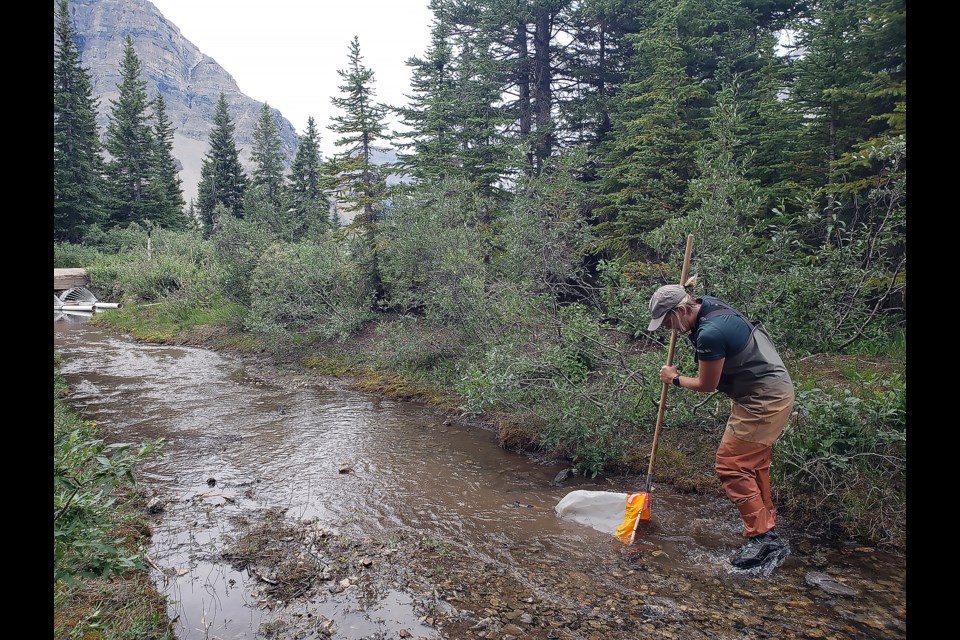LAKE LOUISE – A northern crayfish has been found in Banff National Park – the first time the non-native species has been found in the Bow River system upstream of Calgary.
On Aug. 6, Parks Canada captured a northern crayfish in one of the streams flowing into Bow Lake – the headwaters of the Bow River – about 38 kilometres north of Lake Louise along the Icefields Parkway – following a report a few days earlier.
“The closest location where northern crayfish have been documented is the Calgary area,” said Megan Goudie, Parks Canada’s ecosystem scientist for Lake Louise, Yoho and Kootenay field unit.
Parks Canada’s aquatics team believes the crayfish – which is an aquatic invasive species of concern throughout Alberta – was deliberately transferred into the park, perhaps used as bait for fishing.
“We suspect this was the case of somebody letting an invasive species into the park,” said Goudie.
“Crayfish are used often as bait fish. It’s illegal to use them as bait fish, but unfortunately, it’s a common practice.”
The concern for Parks Canada is that non-native species such as this northern crayfish are disruptive and detrimental to aquatic ecosystems.
“The implications of that are not fully understood at this time, but we do know northern crayfish can alter food webs in an ecosystem,” said Goudie.
“This means they could change the abundance and diversity of food species that are available for our native trout, such as westslope cutthroat trout and bull trout, which are a species at risk.”
In Alberta, northern crayfish have been historically found in the Beaver River watershed south of Edmonton. They are also native to some drainage systems in neighbouring Saskatchewan and Manitoba.
However, the crayfish species has been spreading to lakes and rivers throughout Alberta in the last 10 to 20 years.
Parks Canada’s aquatic invasive species team is now working hard to try to find if there are any other crayfish in the area.
Traps have been set and staff are doing some kicknet sampling, meaning they kick around gravel in the stream into a net, hoping to find any juvenile fish.
Goudie said Parks is also investigating the option of additional techniques such as environmental DNA.
She said the crayfish found was a female of reproductive age, measuring about eight cms in length.
“Unfortunately, with these things, it’s very rare you would find an occurrence of just one,” she said.
One hope is there may be some natural die-off of the invasive species given how cold the water temperatures are in that region of the park. The current surface water temperature at Bow Lake is about 10 C, but this is at the height of summer.
“I think this is something we’re hoping might be the case… it’s very cold,” said Goudie.
“The temperatures of the tributary streams to Bow Lake and Bow Lake itself are definitely on the lowest range of their thermal tolerance for habitat, particularly for spawning, but I won’t say it can't be done.”
The public is being asked to help stop the spread of non-native species into national park waters.
“We’re really trying to get the ‘don’t let it loose’ message out to people,” said Goudie.
“It’s really important to never let any species loose in any water body where they’re not native.”
In addition, if residents or visitors to the park come across a northern crayfish or another invasive species, they are asked to report it.
Parks is asking for a report detailing the locatoin and description of the species, and ideally, a photo, to be sent to the team at [email protected] or phone the Alberta hotline for invasive species at 1-855-336-BOAT.
“We are a team of a certain size and the park is very large, and despite our best efforts, we can't be surveilling all areas at the same time,” said Goudie.
“It would be really helpful for us to be able to concentrate our efforts to determine the distribution if they have established in the area, because it's kind of like looking for a needle in a haystack.”
Last December, the federal government announced $14.7 million in funding over five years to fight aquatic invasive species in Banff, Jasper, Kootenay, Waterton Lakes and Yoho national parks.




